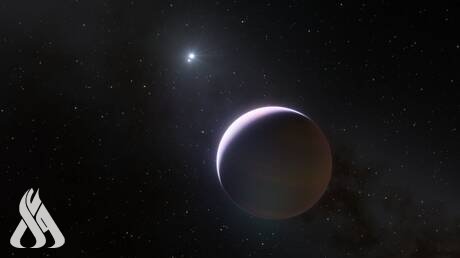
NASA reveals 5 strange things that happen in outer space

- 12-12-2021, 09:51
INA- sources
It doesn’t take an astronomer to know that space is a strange place. But it is how strange it is that might surprise us and make us feel a lot of wonder.
Space is dominated by invisible electromagnetic forces that we do not usually feel. It is also filled with strange types of matter that we have never seen on Earth.
And NASA published on its website a list of five things that happen almost exclusively in outer space.
1. Plasma
On Earth, matter is usually in the form of one of the following three states: solid, liquid, or gaseous.
But in space, 99.9% of matter is in a completely different form, which is plasma.
Composed of free ions and electrons, this material is in a supercharged state that exceeds the gas created when the material is heated to extreme temperatures or combined with a strong electric current.
Most stars in the night sky, including the Sun, are made of plasma. Sometimes they even appear on the ground in the form of bolts of lightning.
Plasma can work collectively, like a team. It conducts electricity and is affected by electromagnetic fields. These fields can control the motions of charged particles in the plasma and create waves that accelerate the particles to enormous speeds.
And space is filled with such invisible magnetic fields that make up plasma trajectories.
And around Earth, the same magnetic field that makes a compass point north directs plasma through space around our planet.
On the sun, magnetic fields release solar flares and bulges directly from the plasma, known as the solar wind, and travel through the solar system. And when the solar wind reaches Earth, it can drive active processes, such as the aurora and space weather, which, if strong enough, can damage satellites and communications.
2. Temperature extremes
The Earth experiences a wide range of temperatures. Records show that the maximum temperatures may reach about 57 degrees Celsius to -89 degrees Celsius.
But what we consider to be extreme on Earth is the average score in space. On planets without an insulating atmosphere, temperatures fluctuate wildly between day and night. Mercury regularly sees days when the temperature is about 449 degrees Celsius, and nights are very cold, reaching -171 degrees Celsius.
It is noteworthy that the satellites and instruments that NASA sends into space are carefully designed to withstand the extremes of space weather.
The astronauts’ suit is also designed to withstand temperatures from -157 degrees Celsius to 121 degrees Celsius. They are white to reflect light during exposure to the sun, and heaters are placed throughout the inside of the suit to warm the astronauts in the dark. It is also designed to provide consistent pressure and oxygen, and to withstand damage from micrometeorites and the sun’s ultraviolet rays.
3. Cosmic chemistry
Right now, the Sun compresses hydrogen into helium in its core. The process of joining atoms together under great pressure and temperature, and forming new elements, is called “fusion”.
And when the universe was born, it mostly contained hydrogen and helium, plus a dash of some other light elements.
Since then, fusion in stars and supernovae has provided the universe with more than 80 other elements, some of which make life possible.
The sun and other stars are excellent fusion machines, as every second, the sun fuses about 600 million metric tons of hydrogen, and this is about 102 times the size of the Great Pyramid of Giza.
In addition to forming new elements, fusion releases huge amounts of energy and light particles called photons, which take about 250,000 years to travel about 700,000 kilometers to reach the surface of the sun visible from the solar core. After that, it takes light only eight minutes to travel 150 million kilometers to Earth.
Fusion, the reverse nuclear reaction that breaks down heavy elements into smaller ones, was first demonstrated in laboratories in the 1930s and is used today in nuclear power plants.
4. Magnetic explosions
Every day, the space around the Earth causes giant explosions. And when the solar wind pushes the current of charged particles from the sun against the magnetic environment that surrounds and protects the Earth, the magnetosphere, they become entangled with the magnetic fields of the sun and Earth.
Eventually, the magnetic field lines fire up and realign, releasing nearby charged particles. This explosive event is known as magnetic reconnection.
And while we can’t see magnetic reconnection with our naked eyes, we can see its effects. Occasionally, some turbulent particles stream into Earth’s upper atmosphere, where they excite the aurora borealis.
Magnetic reconnection occurs throughout the universe wherever there are twisted magnetic fields.
5. Supersonic shocks
On Earth, one easy way to transfer energy is to push something. This often happens through collisions, such as when winds cause trees to sway. But in outer space, particles can transfer energy without touching it. This strange transfer occurs in invisible structures known as shocks.
In the case of shocks, energy is transferred through plasma waves and electric and magnetic fields. For example, imagine the particles as a flock of birds flying together, and if a tailwind catches the birds and pushes them, they fly faster even though nothing seems to be pushing them forward. Particles behave the same way when they suddenly encounter a magnetic field. And the magnetic field could essentially give it a forward thrust.
Shock waves can form when objects are moving at supersonic speed, that is, faster than the speed of sound.
If the supersonic flow encounters something stationary, it forms what is known as the arc shock phenomenon, which occurs when the magnetosphere of an astrophysical object interacts with surrounding plasma flowing nearby such as the solar wind.
The shocks appear elsewhere in space, such as active supernovae ejecting clouds of plasma. In rare cases, shocks can be temporarily created on the ground, and this occurs when bullets and aircraft travel faster than the speed of sound.
It is noteworthy that all five of these strange phenomena are common in space. Although some can be cloned in special laboratory conditions, they cannot often be found under normal conditions here on Earth.
NASA is studying these strange objects in space so that scientists can analyze their properties, providing insight into the complex physics underlying our universe.
Oil prices inch up despite tariff concerns, slowdown fears
- Economy
- 25/03/11
Klopp Tops List of Candidates to Coach Juventus
- Sport
- 25/03/12












